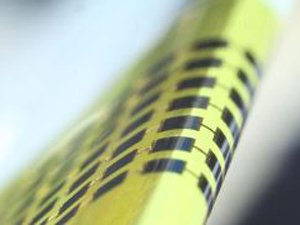



Date:23/06/16
 Flexible, thin-film solar cells are widely considered the future of power generation. Large, rigid panels will likely continue to be the source of large-scale power generation, but bendable solar panels could be placed on any surface from pillars to clothing, which opens up the possibility of gadgets, sensors and more being self-powered.
Flexible, thin-film solar cells are widely considered the future of power generation. Large, rigid panels will likely continue to be the source of large-scale power generation, but bendable solar panels could be placed on any surface from pillars to clothing, which opens up the possibility of gadgets, sensors and more being self-powered.
Scientists in South Korea have pushed the technology forward by creating an ultra-thin solar cell that is so flexible it can bend around a standard pencil without causing damage or stress on the solar cell.
The solar photovoltaic cell is only one micrometer thick, which is far thinner than a human hair, while most thin-film solar cells are between two and four micrometers thick. That extreme thinness is what lets it wrap around something so small.
The solar cell is made from the semiconductor gallium arsenide and then stamped directly on a flexible metal substrate without using an adhesive, which would have added thickness. The cell was fused with the electrode on the substrate by using a cold welding process where pressure was applied at 170 degrees Celsius. The metal bottom layer also acted as a reflector to direct light back towards the solar cell.
In testing they found that the cell was flexible enough to bend around a radius as small as 1.4 millimeters and the solar cells themselves had an energy conversion efficiency similar to thicker thin-film ones. The solar cells also experienced one quarter of the strain from the bending that a cell 3.5 micrometers thick would experience.
“The thinner cells are less fragile under bending, but perform similarly or even slightly better,” said Jongho Lee, an engineer at the Gwangju Institute of Science and Technology in South Korea.
The solar cells could be used in wearable electronics, smart glasses, fabric or integrated into any lower power device that needs to be self-powered like environmental sensors placed in remote areas where it would be difficult to replace batteries or sensors that monitor the health of bridges or buildings.
Solar panels 100 times thinner than a human hair could power wearable technology revolution
 Flexible, thin-film solar cells are widely considered the future of power generation. Large, rigid panels will likely continue to be the source of large-scale power generation, but bendable solar panels could be placed on any surface from pillars to clothing, which opens up the possibility of gadgets, sensors and more being self-powered.
Flexible, thin-film solar cells are widely considered the future of power generation. Large, rigid panels will likely continue to be the source of large-scale power generation, but bendable solar panels could be placed on any surface from pillars to clothing, which opens up the possibility of gadgets, sensors and more being self-powered.Scientists in South Korea have pushed the technology forward by creating an ultra-thin solar cell that is so flexible it can bend around a standard pencil without causing damage or stress on the solar cell.
The solar photovoltaic cell is only one micrometer thick, which is far thinner than a human hair, while most thin-film solar cells are between two and four micrometers thick. That extreme thinness is what lets it wrap around something so small.
The solar cell is made from the semiconductor gallium arsenide and then stamped directly on a flexible metal substrate without using an adhesive, which would have added thickness. The cell was fused with the electrode on the substrate by using a cold welding process where pressure was applied at 170 degrees Celsius. The metal bottom layer also acted as a reflector to direct light back towards the solar cell.
In testing they found that the cell was flexible enough to bend around a radius as small as 1.4 millimeters and the solar cells themselves had an energy conversion efficiency similar to thicker thin-film ones. The solar cells also experienced one quarter of the strain from the bending that a cell 3.5 micrometers thick would experience.
“The thinner cells are less fragile under bending, but perform similarly or even slightly better,” said Jongho Lee, an engineer at the Gwangju Institute of Science and Technology in South Korea.
The solar cells could be used in wearable electronics, smart glasses, fabric or integrated into any lower power device that needs to be self-powered like environmental sensors placed in remote areas where it would be difficult to replace batteries or sensors that monitor the health of bridges or buildings.
Views: 592
©ictnews.az. All rights reserved.Similar news
- The mobile sector continues its lead
- Facebook counted 600 million active users
- Cell phone testing laboratory is planned to be built in Azerbaijan
- Tablets and riders outfitted quickly with 3G/4G modems
- The number of digital TV channels will double to 24 units
- Tax proposal in China gets massive online feedback
- Malaysia to implement biometric system at all entry points
- Korea to build Green Technology Centre
- Cisco Poised to Help China Keep an Eye on Its Citizens
- 3G speed in Azerbaijan is higher than in UK
- Government of Canada Announces Investment in Green Innovation for Canada
- Electric cars in Azerbaijan
- Dominican Republic Govt Issues Cashless Benefits
- Spain raises €1.65bn from spectrum auction
- Camden Council boosts mobile security





















